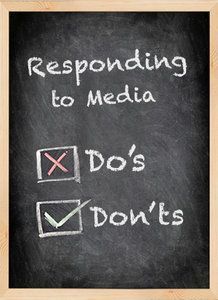Recent laws in New Jersey and California represent a disturbing trend that will negatively impact a practice’s ability to collect monies from patients, as well as expose them to significant penalties if the practice does not follow the mandatory guidelines to a T. Please be aware that a similar law may be coming to your state. The time to act is before the law is passed.
How to Respond When the Media Criticizes Chiropractic: Do's and Don'ts
Editor's note: Drs. Goertz / Lawrence join fellow DC columnist Dr. Anthony Rosner in addressing the recent Forbes opinion piece by Steven Salzberg. Drs. Goertz / Lawrence provide tips on how DCs should (and should not) respond to the article; Dr. Rosner provides an evidence-based rebuttal (click here to read).
By now, most of you are aware of the article recently published by Forbes magazine in which the author, Steven Salzberg, argues that nearly $500 million per year is "wasted on chiropractors." We are sure you had as visceral a response to it as we did, wanting to get in there and defend our profession from the inaccuracies and slant the author built into his writing. And indeed, as of the time we write this, there are already hundreds of responses to that article, many from impassioned chiropractors who point out deficiencies in the article, as well as many that are emotional responses from those who feel hurt by what was written.
Some are thoughtful and will help us; others are less helpful because they fall prey to the same problems in the original article. So, our goal here is to discuss what you should and should not say in responding to articles like this.
The Internet thrives on controversy. Controversy drives Internet traffic (as "click-throughs"), which in turn, is how magazines have been able to monetize visits to their sites, given that fewer people now subscribe to magazines and journals.

While the anonymity of the Net allows people to "act" in ways they never could in public, which contributes to the overall coarsening of our culture, it also provides a means to reach people with important messages. Most news articles today now end with text that usually says something like, "Do you agree that chiropractors waste half a million dollars a year? Click here to post your comments!"
When you do, you had better make sure you have your facts straight. Reading over the comments to the Forbes article, as well as the author's response to some of them (and remember, he can pick and choose the ones he wishes to respond to, meaning he will likely pick the most egregious ones, or the ones that have their facts wrong), demonstrate both the risk and reward of responding.
But here is the rub: We live in an evidence-based world. That's what this column and our blog is all about. That is the language spoken by critics such as this one, and it is the language we need to use in return. In that sense, what you believe about chiropractic is moot; what we need here, to fight this battle, is evidence.
In the responses we read before writing this article, we noted lots of ad hominem attacks (Latin: attack the man). Feels good, but does not address the substance of the article. However, we were heartened because in many of the responses, the writers have provided links to scientific articles.
But a caution here. Linking to just a single trial, for example, may not be the best way to go. It might be better to find a systematic review or meta-analysis to offer, simply because one trial is often not sufficient to make the case. In the circumstances here, the author's argument is about cost; many responders wrote back about effectiveness, which is related, but not the same thing.
Some of the best responses came from the indefatigable J. C. Smith, a chiropractor and writer [search on the DC website for his recent articles, one of which (a two-part series) is a finalist in the ASBPE journalism awards], who supported his comments with extensive reference to scientific literature as well as news reports.
Dr. Smith argued that in comparison to other interventions for back pain, chiropractic is safer, more effective and less expensive – and he offered the citations to support those comments. This is precisely how we should be responding. Our national organizations, both the ACA and the ICA, did the same.
What You Should Not Say or Do
- Do not defend the profession. It does not need a defense, as it does inestimable good.
- Do not attack medicine. Medicine is not the problem, and at this point in our history, with our involvement in VA and DoD centers, and with more and more chiropractors in hospital and integrative settings, medicine is not our enemy. Yes, there are and will always be medical doctors who loath chiropractors and chiropractic. So what?
- Do not let your emotions get the better of you. Revenge seems sweet, but it is hardly the best way to resolve a problem or respond to an attack.
- Do not speak in generalities. The author has made specific charges. Respond to those.
- Don't feel that an attack on our profession is an attack on you.Every profession has its critics. I doubt we get all "het up" [angry and excited] when the law profession and lawyers are criticized. It goes with being a part of the fabric of American society. We are full-fledged members, with wide acceptance. This was not always the case.
- Don't cite research you have not read or may not understand. Don't cite research just to cite research. We have both stronger and weaker research in our profession (as every profession does), and it does us no good to cite the weaker studies.
- Don't go off topic. In writing something for publication, be brief, concise and to the point. No one wants to read a treatise.
- Don't use poor references. You need to know your own professional literature. Information is so easy to find today. Learn how to find it, assess it and use it. PubMed, a main public portal to health information, provides user's guides that can teach you to locate good information.
What You Should Say or Do
A well-cultivated response relies upon good habits of thought using intellectual standards. Here are some tips to help develop critical thinking habits to effectively evaluate a claim and construct a substantive response.
- Do make sure you're completely calm before getting out your pen (or keyboard)!
- Do make sure you have a thoughtful understanding of the article's content, including the main and secondary claims, supporting evidence and rationale. In other words, what is the main point the author is trying to make – and why is he making it? List the claims, supporting evidence and rationale in columns so you can identify gaps. Then list the arguments that make the foundation of your counterclaim. This should form the basis of your response.
- Do analyze the methods used to generate the evidence that supports each claim. Ask yourself, is the author's claim supported by data? Do you have data to support your counterclaim?
- Do consider the quality and quantity of the supporting evidence. Is the data used as supporting evidence compelling? Does it actually support the arguments being made? Has the author neglected to include relevant data because it does not support his argument? What data do you have to support your counterclaim? How strong is that data? In general, data published in the peer-reviewed scientific literature is more compelling than personal opinion (even when that opinion is published in a book that has not undergone the peer review process).
- Do examine the validity of the assumptions and evidence on which the claims are based. What assumptions did the author make? Are those assumptions valid? What assumptions are you making in your counterclaim? Are they valid?
- Do assess your response as critically as you have assessed the original article. Walk through the do's and don'ts with your own work.
These tips will allow you to think more critically about the content of an article, and likewise assist you in formulating a response.
Keep in mind that critical thinking, logic and reason form the foundation of evidence-based practice. Therefore, appropriately applying the principles of critical thinking to evaluate an article and construct a counterargument is necessary for a well-reasoned debate within the scientific community.
Sadly, this approach is unlikely to make you feel as good (in the present moment) as it would to pen a scathing reply that is no more substantiated than the article which enraged you in the first place. However, in the long run, it will be of far more benefit to you, the chiropractic profession and the patients we serve.
Editor's note: This is the third article in a new column focused on evidence-based practice. Future articles will provide evidence-based answers to research-related questions. The column features an affiliated blog where DCs can post questions for the authors. For additional information about Drs. Lawrence and Goertz including a link to their columnist page, visit their blog.



